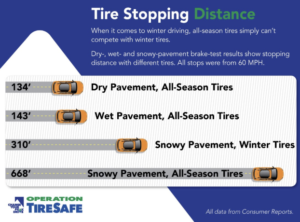There is no doubt about it, Vermont roads are not among the smoothest in the nation. During the winter, asphalt surfaces are at the mercy of snow, rain, cold, warming cycles that convert roads into something you would expect in a war zone. But even in Vermont’s wintry conditions, the use of “all-season” tires is commonplace. For people who overestimate the capability of their all-wheel-drive vehicle, combining all-season tires with all-wheel drive and you have a recipe for all-ways in the ditch.
All-wheel drive is superior to 2 wheel drive when it comes to getting the car going from a dead stop, driving up slick surfaces such as a driveway or the steep stop sign by Shaw’s grocery store. But tests show that all-wheel drive is not helpful when you need to stop or heading into that turn too fast on snowy, icy roads. Look at the chart below regarding braking distances.

Only 25 percent of snow-belt drivers in the United States equip their vehicles with winter tires. Drive north and cross over the Canadian border into Quebec and it is the law for residents to have snow tires on their vehicles from Dec 1- March 15. Additionally, many European countries make their use compulsory due to safety reasons.
In 2005, prior to when Germans were legally required to buy winter tires, there were 12,539 collisions where someone was injured. Compare that to 2008, when the Germans had to buy snow tires, there were only 6,003, a similar trend occurred in Quebec although not as dramatic due to the fact that 90% of Quebec residents had snow tires prior to the law.
How do snow tires help? Snow tires rely on their construction, softer rubber compounds, deeper tread design, and what occasionally feels like a little dose of magic to generate grip on snowy and icy roads. This increased handling and braking of a vehicle in such weather, especially on mountain roads can have a direct impact here in Stowe.
Over the past few years, there has been increased traffic on Mountain Road, and major delays on the way to and from Stowe Mountain Resort. The hill (known as Harlow Hill) from the Matterhorn to the Toll Road, is often the slowest-moving section and all it takes is one car to get sideways and there can be a 2 hr log jam. Furthermore, the impacts are compounded by the snowplows being unable to travel up and down the road creating a vicious cycle of a snowier Moutain Road, more crashes, more waiting and repeat.
If you are one of the three-quarters of drivers who don’t use a set of cold-weather tires, we hope to change your thinking.


